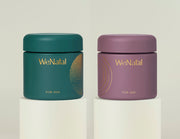
C-Sections Are Major Surgery – and Require Recovery
C-section is a major surgery that requires incisions through the abdomen and uterine lining which will require time and proper nutrition to heal. In fact, major surgery is like running a marathon because they both increase your body’s oxygen and nutritional demands. It can also temporarily disrupt the way your gastrointestinal system functions, so giving your gut extra support during this time is important as well!
Diet and Nutrition Right After a C-section
Immediately after a C-section, you’ll likely only be consuming clear liquids and some ice chips until you pass gas which signals that your digestive system is working. To help support your gut immediately after surgery, consider packing or having someone bring you collagen-rich grass-fed bone broth to drink (bone broth is considered a clear liquid and great to drink regularly in the following weeks/months after recovery). After you pass gas, you’ll slowly add in small amounts of easily digested foods. During this phase, the following strategies can help:
- Consider eating chia seed pudding 1-2 times per day to help support moving your bowels, as this can be one of the most uncomfortable aspects of recovery.
- Drink plenty of fluid with the goal of at least 64oz (8 cups) daily. Even after you pass gas, don’t think you can slack on your fluid intake! Getting enough every day is key for rehydrating after birth, preventing the need for a catheter if you’re unable to urinate, supporting formed and complete bowel movements, and if you’re breastfeeding, aim for 128oz (16 cups) of fluid daily. This doesn’t have to come exclusively from water. Nutrient-dense options like broth, protein shakes, vegetable juices, and soups all count.
- Pack electrolytes! This can make a huge difference to how you feel and your ability to properly rehydrate. One of our favorite options is LMNT.
- Eat and drink smaller quantities more frequently rather than trying to pack in 3 large meals.
- Be sure to chew any solid food thoroughly and eat slowly.
Optimize Healing
Once you progress to a normal diet, there are a few areas of focus that can optimize your healing in the weeks and months after a C-section:
- Protein. Protein needs increase after a c-section because protein helps preserve muscle while also providing the building blocks for the growth of new tissue. Protein also plays a role in immune function. Some of the best sources include pastured eggs, chicken, grass-fed and wild meats, wild-caught seafood, organic dairy if tolerated, legumes, nuts, and seeds.
- Prebiotics and probiotics. Surgery can throw off mom’s motility (how quickly foods move through the intestines) as well as gut microbial balance. Since 70-80% of our immune system is in our gut, we want to give this area extra attention! Eating for gut health includes prebiotic-rich foods that feed the beneficial bacteria. Some of the best sources include asparagus, artichokes, onion, garlic, dandelion greens, and under-ripe bananas. And don’t forget those probiotic-rich foods like kimchi, sauerkraut, and yogurt.
- Fiber. Constipation is very typical after a C-section, and you want to keep things moving to support one of the most important forms of detoxification. It’s best to gradually increase your fiber to at least 25 – 35 grams daily, sometimes more, along with plenty of water to prevent constipation. Some of the best fiber sources include seeds like flax and chia, nuts, berries (especially raspberries and blackberries), beans, lentils, and whole grains. Avoid highly processed and refined foods like white bread, cereal, pasta, and desserts, as these can promote constipation and inflammation!
-
Specific nutrients. During this time, your body will require higher amounts of certain nutrients to support healing and keep inflammation under control. Some of the top nutrients and their best dietary sources include:
- Omega-3 fatty acids: wild-caught salmon, sardines, anchovies, herring, and oysters
- Vitamin A: sweet potato, spinach, pumpkin, carrots, and red bell peppers
- Iron: oysters, white beans, lentils, spinach, and sardines
- Vitamin C: red bell peppers, citrus fruit, kiwi, broccoli, and brussels sprouts
- Zinc: oysters, beef, pumpkin seeds, turkey breast, and dark chocolate
- Copper: oysters, potato, shiitake mushrooms, sunflower seeds, and dark chocolate
- Bonus: bromelain is a mixture of enzymes found in pineapple that have been used for centuries to improve digestion and reduce inflammation. For these reasons, eating pineapple can be particularly helpful!
Can I Take Prenatal Supplements After a C-section?
Finally, the importance of continuing a high quality prenatal supplement can’t be overstated! Not only will it help bridge any gaps in your diet, a high-quality prenatal can promote healing while rebuilding nutrient stores that may have been lost during and immediately following surgery. Also, incorporating an omega-3 fish oil supplement like our Omega DHA+ can help cool inflammation and reduce risk for infection. Whether or not you are expecting a C-section, this information can help empower you and facilitate your healing journey in case this is your experience.



